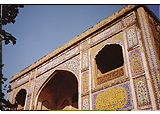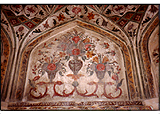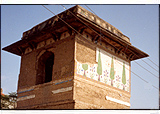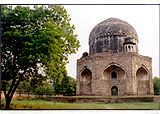 |
|
 |
One fact is
certain: two routes led east from the walled city of Lahore toward
Delhi. An early road ran from the walled city's Delhi Gate southeast
through the village of Mian Mir, named after a prominent Sufi
saint, toward Delhi. Another local road led northeast, paralleling
the old river terrace through the villages of Begumpura and Baghbanpura,
past Shalamar garden, and ultimately rejoining the old road to
Delhi. With the construction of Shalamar garden, this northern
route became the new alignment of the Grand Trunk Road, and it
continues to serve that function today.

Extensive
residences, villages, shrines, and tomb-gardens began to line
the new alignment of the Grand Trunk Road in the mid-seventeenth
century—villages like Kot Khwaja Saeed, Bhogiwal, and Begumpura
(Woman's Town). Begumpura is the most interesting village, in
terms of Mughal gardens, to survive along the Grand Trunk Road
between Lahore Fort and Shalamar garden.

|
 |
|
|
The
sites of Begumpura developed over a hundred-year period from the
mid-seventeenth to the mid-eighteenth century. They include tombs,
gardens, gates, walls, wells, mosques, shrines, and residential
havelis. The principal garden site surrounds a tomb attributed
to Sharf un-Nisa (d. 1671), or Dai Anga, wet nurse to Shah Jahan.
She was a great patron of architecture in her own right and is known
for a mosque she built in Lahore. Her tomb-garden is known as the
Gulabi Bagh (rosewater garden).

|
Gulabi
Bagh Entrance


|
You
enter the Gulabi Bagh from a beautiful tile-decorated gate located,
as is the convention for Muslim tomb-gardens, on its southern side.
Inscriptions on the gateway compare the garden with paradise. The
numerical value of the garden name gives its date as 1066 AH, or
1655 AD (Latif, 1892, 134; Schimmel, 1993). However, the tomb of
Dai Anga dates to 1671, which suggests that a residential garden
was probably converted to the tomb-garden after her death.
 |
Dai
Anga Tomb
Interior Detail
|
 |
|
|
|
The
garden was originally square, with the tomb placed in the center.
The square measured 250 Mughal yards (gaz) on a side, slightly
smaller than the tomb-garden of Asaf Khan in Shahdara, but larger
than those of the great nobles Ali Mardan Khan and Mahabat Khan
which lie to the south and east along the Grand Trunk Road. These
dimensions indicate Dai Anga's social prominence and wealth. Although
the proportions of her tomb, dome, and chattris are somewhat awkward,
they retain vestiges of beautiful blue and yellow glazed tile-work
on the exterior, and the most beautiful surviving floral wall paintings
in Lahore inside.
 |
The
Cypress Tomb


|
Exactly on
axis with the tomb, to the north, lies the so-called Sarvwala
Maqbara (Cypress Tomb), named after the tile decoration on
its upper story. It is an unusual elevated structure said to be
a place of meditation (chilla) and ultimately entombment
for the sister of Nawab Zakaria Khan (Khokhar, 1982; Latif, 1892,
136). There is only one other place like this in Lahore, located
in the village of Kot Khwaja Saeed and called by local residents
Mai Dai, which suggests it too was associated with a prominent
woman in Lahore. The Sarvwala Maqbara dates to the early or mid-eighteenth
century and was originally surrounded by a garden, which is rapidly
being filled in by urban settlement.

Just west of Sarvwala Maqbara lies the village (abadi)
of Begumpura. Its gateways, buildings, architectural details,
and brickwork date to no earlier than 1700 (Baqir, 1984; Latif,
1892). Surviving structures include a mosque with a bangla
(Bengali)-style roof and yellow tile-work, a small serai, and
a gateway with Sikh-styled plaster-work and brick details.

|
Ali
Mardan Khan's
Tomb-Garden


|
West of the
mosque lies the tomb of Khwaja Mahmud, known as Hazrat Eishan,
a religious leader from Bukhara. According to Latif (139), Hazrat
Eishan laid out a beautiful garden. Today, his tomb has a mosque
and small graveyard nearby but no garden. To the northwest is
the Sufi chilla place of Shah Badr Diwan, which does have a small
garden around it. Due south from the tomb of Hazrat Eishan at
a distance of several hundred yards lies the tomb-garden of Ali
Mardan Khan (d. 1657), the great Persian canal and garden builder
under Shah Jahan. His octagonal tomb was set within a garden some
160 to 200 gaz on a side.

Begumpura reminds us that throughout the Mughal period, garden
sites were built in relationship to one another; and that large
areas of the suburban landscape had an orderly spatial organization.
These points hold (albeit in a different way) at the next village
east along the Grand Trunk Road, known as Baghbanpura (Village
of Gardeners).
|
 |
 |
 |
 |
|